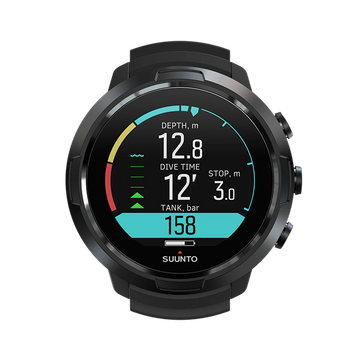

Suunto Blog

William Trubridge swims like a dolphin across wild New Zealand channel
New Zealander William Trubridge has emerged from the Cook Strait jubilant after becoming the first person to complete a channel crossing by swimming underwater.
Trubridge used his incredible breath hold diving ability to swim under the surface, like a dolphin, before surfacing, and diving under again, all the way across. He followed conventional channel crossing rules, such as not resting on a boat or float, except for two changes: all propulsion had to take place underwater on a breath hold, and the use of a wetsuit and fins/monofin was permitted.
“We had strong currents and cold water patches, rough seas, it was like being in a washing machine at times,” he says. “I was getting cramps, cold, blisters, the usual stuff. But I still feel like I got off lightly; there were so many things that could have been different, and for each one of those I probably wouldn’t have made it. I’m feeling a lot of relief and jubilation at the end to make it.”
The Cook Strait separates New Zealand’s North and South islands, and is considered one of the world’s most unpredictable and treacherous stretches of water. At it narrowest points, it’s a mere 22 km across. But what it lacks in lengths it makes up for in fierceness: wild unpredictable weather and powerful currents, chilly water that can cause hypothermia, stinging jellyfish and a population of curious sharks.
“Crossing the Cook Strait is like trying to hit a bullseye, with the target on the back of a bucking bull,” Trubridge says. “The currents are so powerful, and reversed direction at least three times during the swim, mean that hitting the closest piece of land (Perano Head) required constant calculations and course corrections. I’d heard many tales of channel swimmers coming within 500 m of land and battling against currents for another four hours before succumbing to cold and fatigue without reaching the shore.”
The decision to attempt the first “human aquatic crossing” was made suddenly when a good weather window coincided with advantageous low tides. Trubridge had previously done only a few six to eight-kilometer training swims to prepare. “I knew I wasn’t really built for this kind of thing,” he says. “My sport (depth diving) is primarily anaerobic fitness, so I don’t have well developed aerobic muscle fibers. My body type is pretty much the exact opposite of what you need to have for this kind of cold water swimming.”
Thoughts about the plight of New Zealand’s Hector’s and Maui’s dolphins, and wanting to save these precious and intelligent animals, kept Trubridge moving forward despite the challenging conditions and 15-18 degree water. “The main reason for doing it has always been to bring more awareness to the situation with the dolphins,” Trubridge says. “These are the two subspecies of New Zealand dolphin that occupy the North (Maui's Dolphins) and South (Hector's Dolphins) islands. Both subspecies are threatened by extinction.”
Trubridge is calling on the New Zealand Government to act quickly to save the dolphins. The fishing industry must be better regulated to protect the dolphins. He invites divers around the world to put pressure on the New Zealand Government to act before it’s too late.
“I made it across about five times slower and with five times as many dives as it would take a Hector’s Dolphin to make the same crossing, but it showed that if we can swim like a dolphin between our two islands then they too should have the freedom to do the same.”
WATCH NOW: Will Trubridge crosses Cook Strait "like a dolphin"

Five tips for multisport couples
According to USA Triathlon’s “The Mind of a Triathlete 2009 Study” nearly 62 percent of all triathletes are married and 11 percent consider themselves to be in a committed relationship. As you may know, training for an IRONMAN can be a very selfish task, especially if you are trying to punch that ticket to the IRONMAN World Championship. If you are married or married with kids—how do you manage your time with your spouse and your family? What if you both are IRONMAN triathletes craving to punch that ticket to the World Championship or Age Group Nationals?
This is a situation I am familiar with. My husband, Chris, and I each trained for and qualified for Kona at the 2017 IRONMAN Mont Tremblant. With these goals of ours came an important balancing act of how we worked together, trained separately, and supported one another through both our qualifying races and in Hawaii.
As we enter the new year and start setting our racing goals for next season, now would be a good time to talk with your partner to plan for next year and to really make sure that you head into the racing season on the same page. Whether you are both athletes or just one of you is, the point of this discussion should be to make sure both of you have a say in scheduling so no one ends up feeling shortchanged or underappreciated.
Here are five tips for how to optimize your training with your partner so you can each get the support, cameraderie—and sometimes space—that you need to fulfill your racing goals:
1. Organize your work schedule and triathlon training schedule.
The most important task to remember with each other is to understand your partner’s work schedule and training schedule. And if they aren’t in training, factor in the time they spend away from work that is important to them so it doesn’t get left out of the schedule.
A good tool is to use a paper calendar or a calendar app and start plugging in what is crucial for each of your lives. Work is work. Plug that in. Kids have events. Plug it in. Start plugging in each other’s workouts and learn to respect each other’s time for training.
Maybe one triathlete is better at working out in the morning than another, so factor that in to how you will both get those sessions in. Be honest with yourself and with each other so you aren’t signing up for a regular morning swim session that you probably won’t make it to half the time, especially if your partner could use that time for his or her own session.
Tip: Head to Google Calendar and plug in your week on a shared calendar, so you can figure out where you can get your workouts done. Maybe a date night is heading to the pool together and then going out to dinner. Make it fun!
2. Organize your workouts so you can do (some of) them together.
The joys of working out together can be fun, but it can also be a challenge. Maybe one athlete is faster than another or one can lift more than another. Make sure none of your training turns into an “ego fest” with your partner—unless you can do that in a constructive manner!
The biggest takeaway of this is to learn how to do your workouts together, so you can be together. You don’t have to always do the same workout together but at least you can start together or maybe end up at the same post-ride coffee shop.
Sometimes it can be enough to just take the time to drive together to the gym or the pool, even if once you’re there you focus on your own pace and workout goals.
Tip: Try this fun workout in the pool: “10 x 100 Rabbit Chase.” The faster swimmer takes off at the top of the clock. The partner gives them a five-second lead and tries to catch the faster swimmer. Or you can flip flop that. The slower swimmer takes off at the top of the clock. The partner gives them a 10-second lead and tries to catch the slower swimmer.
3. Find a race to do together and make a “race-cation” out of it.
When planning your triathlon racing calendar, you always want to talk with your spouse about what would be an ideal place for you to race both logistically and financially. IRONMAN Hawaii would be the top of the list for a lot of triathlon couples, but remember you have to head to another IRONMAN to get that spot in Hawaii.
Are you celebrating your 20th wedding anniversary? Maybe you head to IRONMAN Australia. Are you trying to save money and you want to drive to an IRONMAN? Maybe you drive to IRONMAN Lake Placid, IRONMAN Wisconsin or IRONMAN Florida (depending on where you live).
When you choose one or two “A” races for the year, consider there location beyond just race day. Are you able to make a “race-cation” out of it? Can you travel to Orlando with the kids after IRONMAN Florida? Can you head to Glacier National Park after IRONMAN Canada?
Tip: Head to the the Convention Visitors and Bureau to find out what you can do beyond your race, and if you have kids, include them in the conversation as well so they will be more supportive of your training and excited for your racing.
4. Find the balance: One races, one is a Sherpa.
When planning your next season, sometimes you both cannot race due to work, family or life.
As the triathlete not racing, it can be difficult to stand on the sidelines, but remember, you have been the one on the start line before and you know what it takes to prepare and get ready for this race.
Your race is to be the best Sherpa your partner needs you to be. Every once in a while head to a workout with them, ride the trainer next to them or meet them on the trails with the kids and hike while they do their long run.
Tip: Suffer in the Pain Cave together. Set the bike trainer up side by side. Watch an hour show, but don’t skip through the commercials. Once the commercial starts, do your interval work. Commercials can go from between three and five minutes, so pick an interval that you can hold within that hour, as you will probably end up doing four rounds of it. Your spouse will be suffering with you, which will make everything better!
5. Find time away of the swim, bike and run.
As endurance athletes, we can get consumed with our workouts, nutrition, the mind set, sleep, etc., but we also have to remember why we said “I do.” Maybe you were athletes when you met. Maybe one of you became a triathlete after you had children.
When you said “I do,” it was for “better or worse” and not “From Sprint triathlon to IRONMAN.” Your union goes beyond the swim, the bike and the run. You need to remember to hold on tight to each other through both of your athletic and non-athletic journeys, and continue to support each other through injuries, burnouts and amazing race results.
Your real race in life is continuing to be a part of the 63 percent in the USA Triathlon 2009 Study. Don’t forget that. And know that it will take work!
Tip: Find something that you love to do together outside the swim, bike and run. Get a regular sitter. Go to a concert. Go for a hike. Go for a cup of coffee and talk.
Living the life as an Endurance Athlete Couple definitely has its perks, but just like anything else, it is something that you have to work together on. Let me tell you this, it was pretty amazing seeing my husband out on the Queen K on his bike racing at the same time I was competing in my first IRONMAN World Championship. The journey to Kona was pretty amazing, but having my husband with me along the way was the cherry on top of that ice cream sundae!
This article by triathlon coach Jen Rulon was originally published on trainingpeaks.com.
TrainingPeaks provides you in-depth analysis, planning tools and coaching services to help you reach your goal. Track your workouts with your Suunto watch. Afterwards analyze your heart rate, power, pace and other data with TrainingPeaks on web or in mobile and progress towards your goals.

Four pointers for running while pregnant
© Lymbus/Sergi Colomé
Being pregnant has meant Emelie Forsberg has had to make some adjustments to her schedule, and reduce the volume of her training. However, it hasn’t stopped her running. While she is taking more care, she is trying to stay active for as long as she can.
“I think (running while pregnant) is so individual, so you can’t compare one woman to another,” Forsberg says. “My first priority is always to listen to my body, especially now that I’m pregnant. I will try to stay active as long as I can. I don’t have any niggles or problem so far.”
According to Andrew Shennan, professor of obstetrics at Kings College in London, running while pregnant is perfectly safe if not overdone. Many people, he says, have misunderstandings about women’s bodies during pregnancy. They are capable of more than you might think.
“Pregnancy is quite a profound state in terms of how it changes your body, however it’s not that delicate,” Shennan says. “In fact, all the evidence says that staying fit and healthy and continuing exercise is a perfectly reasonable thing to do.”
© Lymbus/Sergi Colomé
1. Running is safe (within reason)
Shennan and his colleagues did a study on 1200 pregnant runners. The study compared those that stopped running with those that continued, and then compared those that continued into different phases of pregnancy, and also by their running volume, and those that stopped. The study found the pregnancies of women who chose to give up running were no different from those who continued to exercise throughout their pregnancy.
“All the evidence on moderate exercise and recreational exercise is that doing it regularly and consistently does not influence when you go into labour, or the way your baby grows and develops,” Shennan says. “You can be reassured that mild exercise is perfectly reasonable.”
2. It’s actually a good thing
Not only is moderate, regular exercise safe, it’s also a good thing. Shennan says there is good evidence that being a good weight and physically fit is helpful for pregnancy and during labor.
“From a general point of view we encourage women to exercise about 30 minutes everyday,” he says. “Entering pregnancy at an optimal weight is a very good prerequisite for a healthy pregnancy. We know that healthy pregnancies create healthy children. Being fit and healthy will programme your baby in utero for lifelong health.”
Professor Andrew Shennan is Professor of Obstetrics at King’s College London, based at St. Thomas’ Hospital.
3. Don’t push it
Yes, running is safe and even healthy, but caution is required. Because pregnant women pump 40 % more blood, their hearts have to work harder, increasing their average heart rate.
“The placenta is very sensitive to blood flow and doesn’t have autoregulation like other organs have,” Shennan says. “This means that if you are becoming a bit hypoxic (low in oxygen), it will have a direct effect on the placenta. Therefore, it’s really important not to push it. If you are running in the red zone that’s probably not a good thing. I would stay within your comfort zone, and listen to your body.
“Remember the benefits you get from exercising at suboptimal levels are often underestimated. Focus on maintaining your fitness while pregnant rather than trying to gain.”
4. Avoid falling at all costs
Hormone activity in pregnancy softens ligaments, and reduces bone mass, increasing the risk of injury. The ability to balance and posture change in the second and third trimester. All of this means women can become more injury prone.
“The lesson is be careful and not to do crazy things,” Shennan says. “The one big thing to avoid is trauma. We know that trauma, direct impact to the uterus, is a bad thing. If you have a little fall, and you knock your bump, there can be what we call subclinical bleeds behind the placenta and they can build up and cause a catastrophic event a day or two later. So even minor trauma is not good thing.”
Final word: enjoy your running
When Shennan was conducting the study of 1200 pregnant runners, one woman contacted him to ask if she should continue running. She said she had cut down her training volume to 20 km a day. Shennan said he didn’t know whether that was safe. She continued running in this way and encountered no problems during her pregnancy or the birth.
“As an obstetrician, I’m not encouraging woman to do that because I think it’s probably a bit much,” he says. “However, I do encourage pregnant woman to carry on doing their accustomed exercise. Just be prepared to slow down a bit.”
Lead image: Photo by Curtis MacNewton on Unsplash

Fuelling the engine: Talking nutrition with Ultra Cycling Man
© Luigi SestiliItalian endurance cyclist Omar di Felice pushes his body through tough conditions, subzero temperatures in Norway’s icy reaches, or sweltering heat in Spain over summer. Extremes are his speciality.
This is only possible, he says, because of his careful nutrition plans. “When you keep pushing your body to the limit everyday you have to introduce the right balance in terms of calories and nutrients to get enough energy,” he says. “The first thing is to correctly balance the right quota of fat, proteins and carbohydrates”
This becomes more challenging while traveling or on a long training ride, which is why careful forward planning is so essential. Fortunately, di Felice gets supported by his girlfriend, a food blogger in Rome. She specializes in pastries, and makes di Felice plenty of cake.
© Luigi Sestili
Long distance, multi-day, rides, burn through a lot of calories quickly. That’s why di Felice follows a “fat-based nutrition” plan. “Fat is the best fuel when you are riding for hours and days, and you need lots of energy to stay focused on a long distance ride,” di Felice says. “At the same time, protein is important so you don’t burn too much muscle. And carbohydrates are important for the brain and to have quick available energies, but you need to be careful not to have too much.”
When he’s out on a long ride and doesn’t have time to stop to prepare a meal, di Felice has a few quick, go to meals, including one of his favourite foods: ice cream. Bread with ham, cheese and cake are his other regulars.
“I always try to keep in mind that, without the right energy supply, I won’t be able to do my daily training,” he says. “Nutrition is really important in my life.”
Power bar recipe: Cioccoriso
Ingredients:
300 grams dark chocolate200 grams puffed ricecoconut flakes
Method:
Put the puffed rice in a bowl with the melted chocolate and mix well. Then take a thermometer and check the temperature. Keep mixing, when it’s between 32-33°C, you can start to make the bars with a spoon on baking paper. Why not before? Because to get a good result with chocolate you have to find the right temperature, only this way the cioccoriso will be compact and will remain shiny. Leave the cioccoriso at room temperature for 40 minutes and you will see the bars reach perfection!
Recipe from: Sara De Simoni - Burro & Miele
Lead image: © Omar di Felice and © Luigi Sestili
For more articles in the Fuelling the Engine series click below:
D.I.E.T (DISASTER IMMINENT EVERY TIME ®) AND THREE UNCHANGING PRINCIPLES OF NUTRITION FOR ATHLETES.
FUELLING THE ENGINE: TALKING NUTRITION WITH EMELIE FORSBERG.
FUELLING THE ENGINE: TALKING NUTRITION WITH MELISSA HAUSCHILDT.
FUELLING THE ENGINE: TALKING NUTRITION WITH LUCY BARTHOLOMEW.
FUELLING THE ENGINE: A COMMONSENE APPROACH TO NUTRITION.

3 Ways to Motivate Yourself to Train This Winter
On the whole we endurance athletes are a pretty self-motivated bunch. But even endurance athletes are only human, and as a result we suffer from the same fluctuations in “get up and go” as everyone else from time to time. These dips in motivation can range from the nagging desire to skip training for a day or two to full on slumps where you lose your workout mojo altogether for extended periods of time.
And this time of the year can be particularly challenging from a “mojo” point of view because, for the most part, the “A” races for the year have disappeared into the rear view mirror but next season is still a good way off over the horizon.
There are also dark mornings and evenings with often colder, wetter weather to contend with (for those of us in the Northern Hemisphere at least). At this time of the year it’s easier than ever to just skip training altogether.
Don’t get me wrong, I do believe in taking a decent end-of-year break if you’ve had a long, hard season. This is crucial for mental and physical recuperation. But, assuming that your planned downtime is coming to an end sometime in the near future, I thought it might be a good time to offer up a few tips gleaned from more than 20 years of tricking, cajoling and persuading myself to go out and train when frankly I’d much rather have hit the snooze button or spent more time working on the Homer Simpson-esque butt indentations in my sofa instead.
Set your next goal ASAP
Over the years I’ve learned that lining up your next significant goal is the best way to motivate you to train. It’s why I’ve tried to carry on doing a fairly big event each year even though I’m nowhere near as competitive as I used to be.
I simply find that without something fairly challenging in the diary in the not too distant future, I am far more likely to give in to the urge to skip a session when I just don’t feel like it. Without a significant goal on the horizon, I find that something of a downward spiral kicks in. Missed workouts lead to a significant drop in fitness levels followed by similar drop-offs in mood, self-confidence and overall productivity in life.
In contrast, when I have a decent high-level goal in place the opposite tends to happen. Aiming for the goal has a positive “double-whammy” effect on my motivation and willingness to put the work in. It gives me something very positive to visualize and strive toward when I’m feeling motivated and up for training anyway, acting as a kind of multiplier of effort and enjoyment on those days.
And even more importantly, it does a great job of mildly scaring and pressuring me into making that crucial first step out of the door on those days where I’m feeling less than up for it. That’s largely because I’m fearful of the consequences of not doing so; namely falling short of the goal in some way.
I’m actually going through the process of choosing a couple of goals for the year at the moment. If you’ve not set your mind to what you want to be doing this year yet, I’d definitely recommend doing so soon.
Plan to train with other people
Training with other people adds the pressure of not letting them down and this alone is a powerful motivator. Training with others can also be a lot of fun and it can help distract you a bit and give you another, more sociable reason to go training.
I’ve always found evening training to be the hardest to get motivated for. I’ve therefore taken to arranging to go training with other people on days where my work schedule dictates that I have to put sessions in after dinner rather than first thing in the morning (which I definitely prefer).
More often than not, the pressure of having to show up and not let someone else down is the deciding factor in getting me out and putting in the miles. And, somewhat unsurprisingly, I almost always find that I either enjoy the training once it’s underway or at the very least get a sense of satisfaction from it once it’s done.
Plan tomorrow, tonight.
Having the discipline to spend two minutes at the end of each day thinking about what training you’re going to do the next day can be hugely beneficial.
When you’re working to a set training plan this mental checklist is nothing more than a brief chance to think through what your program has in store; to make sure you feel like you’re up to it and to check you have everything you need ready (kit/equipment laid out or packed, alarm set for the right time, any foods and drinks prepared etc).
This reduces the chances of anything small or silly preventing you from getting the job done the next day and it allows you to adapt your plan if you feel you need to.
When you’re not working to a long-term structured plan (as can be the case at this more relaxed time of year), taking a couple of minutes to plan out what you intend to do tomorrow, and when you intend to do it, is even more important. It dramatically increases your chances of actually knuckling down and doing some productive training.
I’ve done a fair bit of reading on this subject (as well as thinking about my own tendencies) and I think this is largely because we have 3 different “selves”: our Past Selves, Present Selves and Future Selves. The implications of this theory go way beyond training, but here’s my extremely basic interpretation of how it applies to athletes:
Your Present Self almost always wants to do something that’s easy and rewarding right now e.g. hit snooze and stay in the warm bed, or stay parked in front of the TV. However, what your Future Self would actually benefit from most of all is doing something harder right now, i.e. getting your kit on and going training, as this will result in your Future Self being fitter in the long run.
In other words, your Future Self needs your Present Self to take some pain now for gain later on, whereas Present Self is far more interested in avoiding the pain in the immediate term. It’s as if you’re actually two different people with two different sets of goals.
So, when you sit down the night before the following day to mentally commit to what training you’ve got planned, what you’re actually doing is proactively putting your Future Self’s best interests to the fore whilst you’re not feeling the strong pull of Present Self’s desires.
When the alarm goes off the following morning, you wake up having effectively made a pact with your Past Self to get up and go to give your Future Self the best shot at hitting their goals. This makes it quite a bit harder for Present Self to take the reigns and simply turn off the alarm and roll over.
The psychology of human motivation is clearly more complicated than this simplification, but I do know from my own experience that thinking about things in this way (and pre-agreeing the following day’s training the night before with myself) is a very helpful tool for getting me up and out of the door.
Success with endurance training is largely a product of the consistency with which you can grind it out over many months, so I hope that these tips help you get out of the door just a little more regularly in the coming weeks and contribute to you starting the new year with the best possible chance of having a great season.
This article by Andy Blow, a coach and a triathlete, was originally published on trainingpeaks.com.
TrainingPeaks provides you in-depth analysis, planning tools and coaching services to help you reach your goal. Track your workouts with your Suunto watch. Afterwards analyze your heart rate, power, pace and other data with TrainingPeaks on web or in mobile and progress towards your goals.
READ ALSO
TAKE THE LONG LOOK: HOW TO PLAN (VERY) FAR AHEAD IN ORDER TO REACH YOUR GOALS
3 THINGS YOU NEED TO DO BEFORE SETTING YOUR NEXT RACE GOAL

Fuelling the engine: Talking nutrition with Ryan Sandes
Avocados are a staple in Sandes’s diet. © Craig Kolesky / Red Bull Content Pool
Back home in his native South Africa, ultra runner Ryan Sandes is partial to a good braai (the South African version of a barbeque). While he generally eats whole foods most of the time, Sandes avoids getting strict or uptight about his diet. He takes a pragmatic approach.
“I believe it's important to enjoy life as well,” he says. “I don’t weigh x amount of protein, and x of carbs, I just try to eat a balanced diet with as many whole foods as possible. I try to listen to what my body is craving.”
Despite being from meat loving South Africa, Sandes and his wife Vanessa have drastically reduced their meat consumption to only once or twice a week. Instead, they focus on eating unprocessed, natural food.
“As an athlete it’s very easy to slip into taking lots of recovery shakes to try to get the goodness back into your body,” Sandes says. “But I don’t think you can replace eating good whole foods.”
Sandes ran the Great Himalayan Trail this year. © Dean Leslie / Red Bull Content Pool
In busy times
Forward planning is essential for athletes. And having a good meal plan is just as important as having a clear training plan.
Sandes often makes a big dish, with multiple portions, at the beginning of the week so he has something easy available if it’s a busy week. It’s helpful doing this, he says, because of the tendency to get a little lazy, especially later in the week.
“I often eat quite a lot of eggs, and avocados and salad, things that are easy to put together,” he says.
Sandes (and his dog) remains partial to a braai (barbecue). © Ryan Sandes
Go to meals
Sandes enjoys pizza so, when he needs an easy meal, he buys locally made pizza bases, smothers them vegetables and salad, and bakes them. Burgers, smoothies, rye bread with honey, muesli and plenty of boiled eggs are all part of his regular diet, too.
And his secret supplement is bone broth.
“These days in first world countries people eat the best cuts of meat, whereas way back in the hunter-gatherer days, if they hunted a buck they would eat the entire animal, including boiling all the bones and drinking the broth,” Sandes explains. “A lot of the good meat cuts don’t have all the essential fats, but bone broth has that. It’s not my favourite thing, but it’s great for recovery.”
The Sandes superfood grain salad recipe
Grains:
1 cup of quinoa1 cup of sorghumHalf a cup of milletHalf a cup of buckwheat
Boil all the grains separately as they all have varying cooking times.Add a can of drained and rinsed chickpeas and a can of drained and rinsed lentils.Let the grains cool down and add some lemon juice and good quality olive oil. The above amounts make quite a big bowl but you can keep it in the fridge and decant from it all week for lunch and dinner!
Other ingredients:
Chopped up avocado pearRocket and other lettuce leaves Baby spinach leavesFeta cheesePitted olivesBaby tomatoes
Salad dressing:
1/4 cup of balsamic vinegar1/2 cup of good quality cold extracted olive oil1 teaspoon of honey1 teaspoon of whole-grain or Dijon mustardOne clove of crushed fresh garlicSalt & pepper to taste
Blend all the salad dressing ingredients and lightly drizzle onto your salad. For more of an animal protein punch, add slices of grilled chicken, beef or tuna. Optional extras: drained and rinsed can of corn, chopped up fresh basil, drained and rinsed butter or cannellini beans, cut up cucumber, half a hand-full of dried cranberries.
Lead image: Photo by Jaco Pretorius on Unsplash
Read more stories about nutrition:
Fuelling the engine: A common sense approach to nutrition
Fuelling the engine: Talking nutrition with Melissa Hauschildt
Fuelling the engine: Talking nutrition with Lucy Bartholomew































































